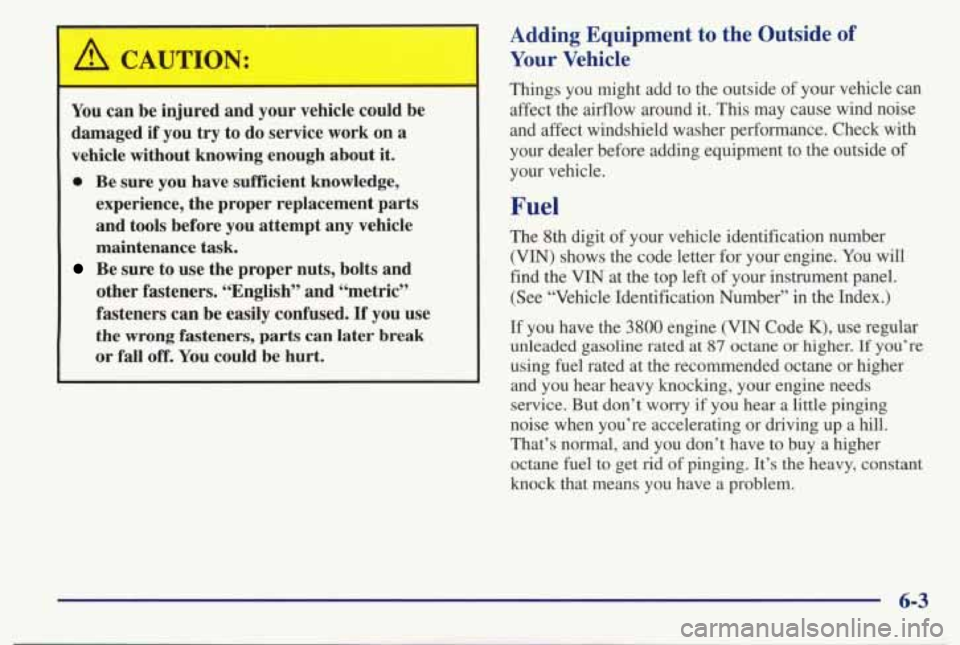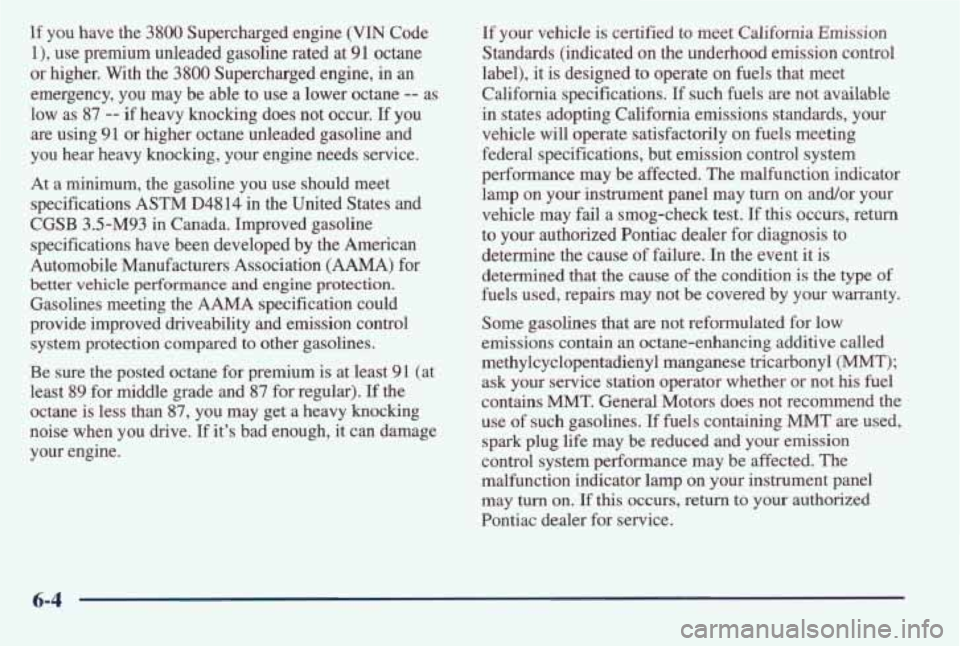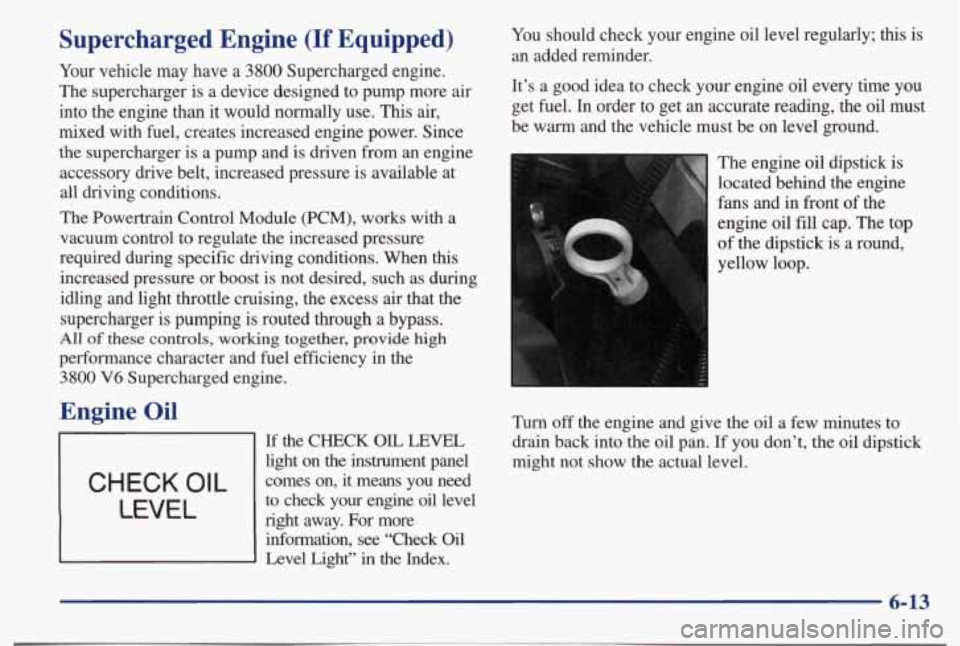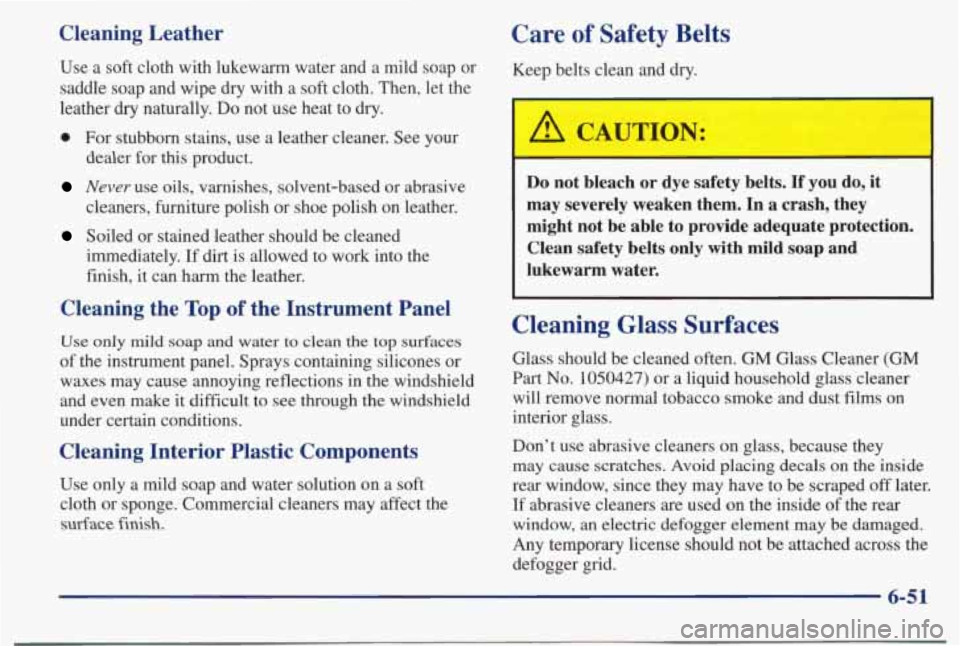Page 254 of 395

/1 CAUTION:
You can be injured and your vehicle could be
damaged
if you try to do service work on a
vehicle without knowing enough about it.
0 Be sure you have sufficient knowledge,
experience, the proper replacement parts
and tools before you attempt any vehicle
maintenance task.
Be sure to use the proper nuts, bolts and
other fasteners. “English” and “metric”
fasteners
can be easily confused. If you use
the wrong fasteners, parts can later break
or fall
off. You could be hurt.
Adding Equipment to the Outside of
Your Vehicle
Things you might add to the outside of your vehicle can
affect the airflow around it. This may cause wind noise
and affect windshield washer performance. Check with
your dealer before adding equipment to the outside
of
your vehicle.
Fuel
The 8th digit of your vehicle identification number
(VIN) shows the code letter for your engine. You will
find the VIN at the top left
of your instrument panel.
(See .“Vehicle Identification Number”
in the Index.)
If you have the 3800 engine (VIN Code K), use regular
unleaded gasoline rated at 87 octane or higher. If you’re
using fuel rated at the recommended octane or higher
and you hear heavy knocking, your engine needs
service. But don’t
worry if you hear a little pinging
noise when you’re accelerating or driving up a
hill.
That’s normal, and you don’t have to buy a higher octane fuel to get
rid of pinging. It’s the heavy, constant
knock that means you have a problem.
6-3
Page 255 of 395

If you have the 3800 Supercharged engine (VIN Code
l), use premium unleaded gasoline rated at 91 octane
or higher. With the
3800 Supercharged engine, in an
emergency, you may be able to use a lower octane -- as
low as
87 -- if heavy knocking does not occur. If you
are using
91 or higher octane unleaded gasoline and
you hear heavy knocking, your engine needs service.
At a minimum, the gasoline you use should meet specifications
ASTM D4814 in the United States and
CGSB 3.5-M93 in Canada. Improved gasoline
specifications have been developed by the American
Automobile Manufacturers Association
(AAMA) for
better vehicle performance and engine protection.
Gasolines meeting the AAMA specification could
provide improved driveability and emission control
system protection compared to other gasolines.
Be sure the posted octane for premium is at least
91 (at
least
89 for middle grade and 87 for regular). If the
octane is less than
87, you may get a heavy knocking
noise when you drive. If it’s bad enough, it can damage
your engine.
If your vehicle is certified to meet California Emission
Standards (indicated
on the underhood emission control
label), it is designed to operate on fwels that meet
California specifications. If such fuels are not available
in states adopting California emissions standards, your vehicle will operate satisfactorily
on fuels meeting
federal specifications, but emission control system
performance may be affected. The malfunction indicator lamp on your instrument panel may
turn on and/or your
vehicle may fail a smog-check test. If this occurs, return
to
your authorized Pontiac dealer for diagnosis to
determine the cause of failure.
In the event it is
determined that the cause of the condition
is the type of
fuels used, repairs
may not be covered by your warranty.
Some gasolines that are not reformulated
for low
emissions contain
an octane-enhancing additive called
methylcyclopentadienyl manganese tricarbonyl
(MMT);
ask your service station operator whether or not his fuel
contains
MMT. General Motors does not recommend the
use of such gasolines. If fuels containing MMT are used,
spark plug life may be reduced and your emission
control system performance may be affected. The
malfunction indicator lamp
on your instrument panel
may
turn on. If this occurs, return to your authorized
Pontiac dealer for service.
6-4
Page 264 of 395

Supercharged Engine (If Equipped)
Your vehicle may have a 3800 Supercharged engine.
The supercharger is a device designed to pump more air
into the engine than it would normally use.
This air,
mixed with fuel, creates increased engine power. Since
the supercharger is a pump and is driven from an engine
accessory drive belt, increased pressure is available at
all driving conditions.
The Powertrain Control Module (PCM), works with a vacuum control to regulate the increased pressure
required during specific driving conditions. When this
increased pressure or boost is not desired, such
as during
idling and light throttle cruising, the excess
air that the
supercharger is pumping is routed through
a bypass.
All of these controls, working together, provide high
performance character and fuel efficiency in the
3800 V6 Supercharged engine.
Engine Oil
CHECK OIL
LEVEL
If the CHECK OIL LEVEL
light on the instrument panel
comes
on, it means you need
to check your engine oil level
right away.
For more
information,
see “Check Oil
Level Light” in the Index. You
should check your engine oil level regularly;
this is
an added reminder.
It’s
a good idea to check your engine oil every time you
get fuel.
In order to get an accurate reading, the oil must
be warm and the vehicle must be on level ground.
Turn
off the engine and give the oil a few minutes to
drain back into the oil pan. If you don’t, the oil dipstic\
k
might not show
the actual level.
6-13
Page 302 of 395

Cleaning Leather
Use a soft cloth with lukewarm water and a mild soap or
saddle soap and wipe dry with a soft cloth. Then, let the
leather
dry naturally. Do not use heat to dry.
0 For stubborn stains, use a leather cleaner. See your
Never use oils, varnishes, solvent-based or abrasive
dealer for this product.
cleaners, furniture polish
or shoe polish on leather.
Soiled or stained leather should be cleaned
immediately.
If dirt is allowed to work into the
finish, it can harm the leather.
Cleaning the Top of the Instrument Panel
Use only mild soap and water to clean the top surfaces
of the instrument panel. Sprays containing silicones or
waxes may cause annoying reflections in the windshield and even make it difficult
to sed Wough the windshield
under certain conditions. ..
Cleaning Interior Plastic Components
Use only a mild soap and water solution on a soft
cloth or sponge. Commercial cleaners may affect the
surface finish.
Care of Safety Belts
Keep belts clean and dry.
~
A CAUTION:
-
Do not bleach or dye safety belts. If you do, it
may severely weaken them. In a crash, they
might not be able to provide adequate protection. Clean safety belts only with mild
soap and
lukewarm water.
Cleaning Glass Surfaces
Glass should be cleaned often. GM Glass Cleaner (GM
Part No. 1050427) or a liquid household glass cleaner
will remove normal tobacco smoke and dust
films on
interior glass.
Don’t use abrasive cleaners on glass, because they
may cause scratches. Avoid placing decals
on the inside
rear window, since they may have to be scraped
off later.
If abrasive cleaners are used on the inside of the rear
window, an electric defogger element may be damaged.
Any temporary license should not be attached across the
defogger grid.
6-51
Page 307 of 395
Appearance Care Materials Chart
12377984 I 16 oz. (0.473 L) I Surface Cleaner I Removes contaminants, blemishes and swirl marks
See your General Motors Parts Department for these products. ** Not recommended for use on instrument panel vinyl.
See “Fluids
and Lubricants” in the Index.
Page 308 of 395
Vehicle Identification Number (VIN)
SAMPLE4UXWM072675 I
ENGINEA998 7 ASSEMBLY
CODE MODEL YEAR PLANT
This is the legal identifier for your vehicle. It appears
on a plate in the front corner of the instrument panel,
on
the driver’s side. You can see it if you look through the
windshield from outside your vehicle. The VIN also
appears on the Vehicle Certification and Service Parts
labels and the certificates of title and registration.
Engine Identification
The 8th character in your VIN is the engine code. This
code will help you identify your engine, specifications
and replacement parts.
Service Parts Identification Label
You’ll find this label on your spare tire cover. It’s very
helpful if you ever need to order parts. On this label is:
your VIN,
the model designation,
paint information and
a list of all production options and
special equipment.
Be sure that this label is not removed from the vehicle.
Page 311 of 395
Driver’s Side Fuse Block
The driver’s side fuse block is to the left of the steering
wheel, under the instrument panel.
Snap
off the cover to reveal the fuses. You’ll find a fuse
puller clipped
to the inside of the cover. Place the wide
end of the fuse puller over the plastic end
of the fuse.
Squeeze
the ends over the fuse and pull it out.
Spare fuses are located
in the slots labeled “Spare” on
the following chart.
When finished, replace the cover
by snapping it back up
into place.
12345 6789
Page 313 of 395
Fuse
7D
8D
9D
1E
2E
3E
4E
5E
6E
7E
8E
9E
Usage
Not Used
Radio
Not Used
Not Used
Air
Bag System, PASS-Key
Not Used
Not Used Rear Defog
Not Used Non-OBD
II Engine Miscellaneous
Wipers, Washer
Not Used
Passenger’s Side Fuse Block
Additional fuses are located in the relay center, on the
passenger’s side, below the instrument panel. You must
remove the sound insulator
on the right side of the
passenger footwell
to replace these fuses.
Since replacing these fuses is difficult. We recommend
that you see your dealer
if you need one replaced.
6-62